International team establishes a new type of autism non-human primate model
June 13, 2019 Source: Shenzhen Institute of Advanced Science, Chinese Academy of Sciences
Window._bd_share_config={ "common":{ "bdSnsKey":{ },"bdText":"","bdMini":"2","bdMiniList":false,"bdPic":"","bdStyle":" 0","bdSize":"16"},"share":{ }};with(document)0[(getElementsByTagName('head')[0]||body).appendChild(createElement('script')) .src='http://bdimg.share.baidu.com/static/api/js/share.js?v=89860593.js?cdnversion='+~(-new Date()/36e5)]; On June 13th, the Shenzhen-Hong Kong Brain Science Innovation Institute (hereinafter referred to as “Shenzhen-Hong Kong Brain Instituteâ€), which was built by the Shenzhen Institute of Advanced Technology of the Chinese Academy of Sciences (hereinafter referred to as “Shenzhen Advanced Instituteâ€), and the brain analysis in Shenzhen planning and Brain simulation of major scientific and technological facilities (referred to as "brain facilities") research platform released the latest development: the brain science international team jointly tackled the problem, successfully prepared a new non-human primate model that mimics the human autism SHANK3 gene mutation.
The establishment of this model lays an important foundation for the analysis of the mechanism of autism and the development of clinical intervention methods. It is one of the key breakthroughs in the research of animal models of brain diseases in the international neuroscience community in recent years. The result was published in the long form in Nature (see the end of the article "Read the original text"), Shenzhen Advanced Institute is the first unit of the paper.
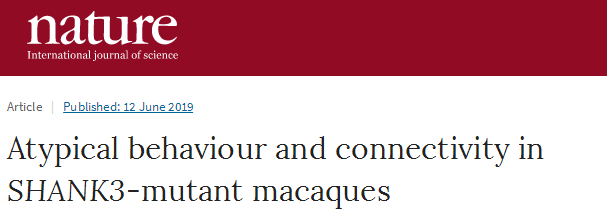
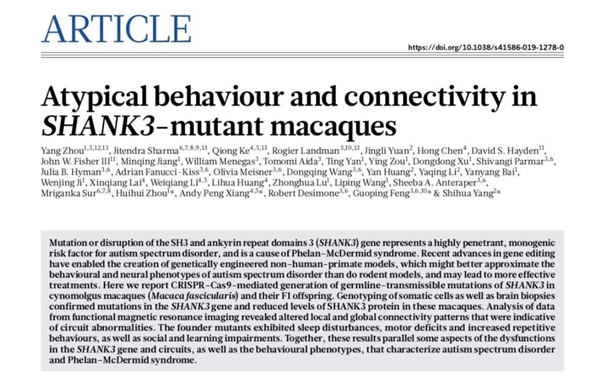
International team gathers and innovates to explore the autism problem
Autism is a relatively common and serious neurodevelopmental disease. The main symptoms are social disorders, language disorders and repetitive stereotypes, and even mental retardation. According to the "Report on the Development of China's Autism Education and Rehabilitation Industry", the number of autistic patients in China has exceeded 10 million, of which more than 2 million children from 0 to 14 years old, and the prevalence rate is still on the rise in recent years. At present, the medical community has not yet discovered the exact cause and pathogenesis of autism, and rehabilitation training, as a recognized and effective treatment, can only improve and cannot be completely cured.
One of the authors of the article, Zhou Huihui, a researcher at the Institute of Brain Cognition and Brain Diseases at Shenzhen Advanced Institute, said that the non-human primate model is close to human evolution and has many similarities with humans in terms of brain structure and function. For example, the primate model has a more developed prefrontal cortex, which is at the heart of the decisions, attention, and social behaviors that are closely related to brain diseases such as autism. "Non-human primates are expected to be ideal animal models for simulating some human brain diseases."
Scientists have identified hundreds of autism-associated genetic variants, but most individual genetic variants have little effect on autism. The researchers conducted an in-depth study of the highly relevant SHANK3 gene in autism and found that non-human primates carrying the SHANK3 mutation showed similar behavioral characteristics and brain connectivity patterns to autistic populations.
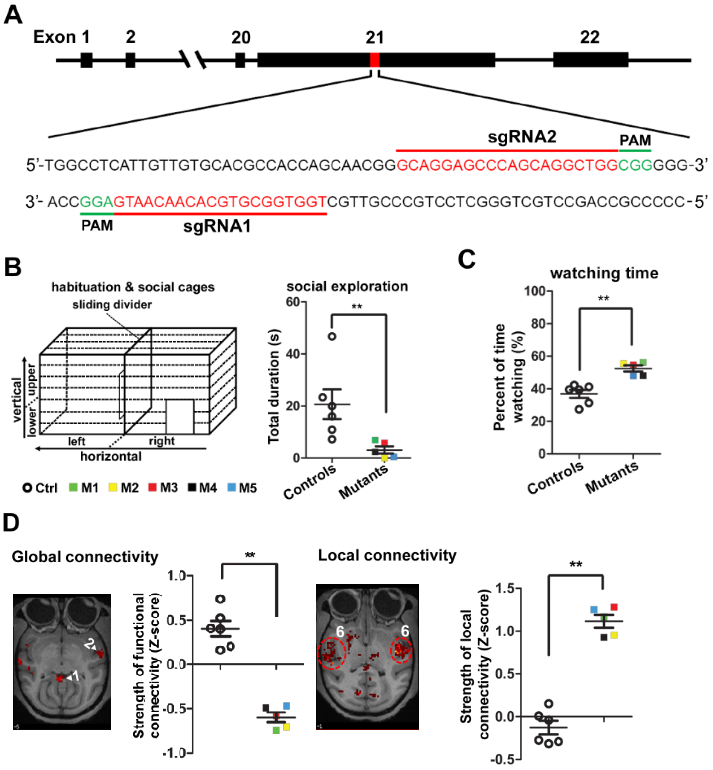
The SHANK3 mutant monkey showed symptoms associated with autism.
It is understood that the research results of this non-human primate model rely on the Shenzhen-Hong Kong Brain Institute platform, and the international team of the Institute of Brain Cognition and Brain Diseases of the Shenzhen Advanced Institute, the Massachusetts Institute of Technology, Sun Yat-sen University, and the South China Agricultural University. Carry out.
Robert Desimone, director of the McGovern Brain Institute at the Massachusetts Institute of Technology, said: "We believe that non-human primate models will understand the pathology of autism and promote drug development in the future. And the application will play a positive role."
Building a first-class platform to target the international frontier Shenzhen Innovation Soil Cultivation Brain Science Leading Team
Innovative fertile soil is fruitful, and the forward-looking layout wins the first opportunity.
Five years ago, Shenzhen aimed at the commanding heights of the future technology, combining innovation-driven development with the forefront of international brain science, pre-emptively deploying, supporting the Shenzhen Advanced Institute to establish a brain cognitive and brain disease research institute, and gathering international innovation resources to establish a non-human spirit. Long-term brain science research platform. The research platform won the first internationally-accepted AAALAC qualification certification for the management and use of laboratory animals in Shenzhen in 2018. This not only helps the Shenzhen Advanced Institute team to conduct scientific research cooperation with domestic and foreign teams, but also to use the animal model for the future. It has laid a good foundation for the development of new drugs to solve the problem of autism and cooperation with biopharmaceutical companies at home and abroad.
"If there is no non-human primate research platform that is in line with international standards, we will not have the results of our research. Thanks to the strong support of Shenzhen. Based on the continuous construction of this platform, through the unremitting efforts of researchers and through closer cooperation with the industry. We are confident that we can make more influential results," Wang Liping said.
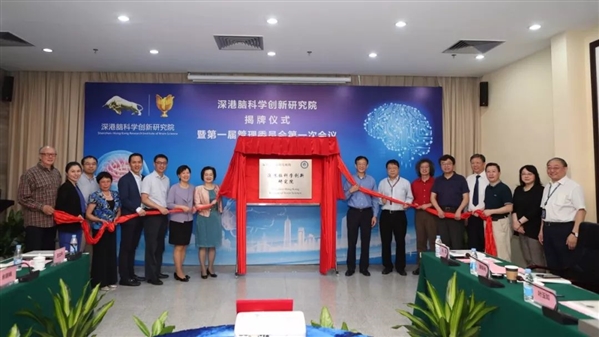
Shenzhen-Hong Kong Brain Science Innovation Institute unveiled
Thanks to the innovative consciousness of Shenzhen's “forward-looking layout and planning for the futureâ€, Shenzhen City focuses on the deployment of large-scale, brain-based facilities featuring the development and industrialization of non-human primate brain disease models based on the Shenzhen Advanced Institute. Shenzhen Hong Kong Brain Hospital will provide an open technology platform for the development of brain science in Guangdong, Hong Kong and Macao.
"With this non-human primate autism animal model as an example, relying on brain facilities and Shenzhen-Hong Kong Brain Hospital, we can not only understand this brain disease by developing new tools, but also use this broader platform. Develop more brain disease models, serve the development of brain disease drugs, and work hard to solve the common brain disease pain problems and serve the brain health industry."

Brain analysis and brain simulation
It is understood that Shenzhen is relying on the Shenzhen Advanced Institute, and the brain facilities built by the Shenzhen-Hong Kong Advantage Brain Science Team have broken ground. The Shenzhen-Hong Kong Brain Institute has been officially awarded in January this year, and has talents and achievements in the brains of the Shenzhen Advanced Institute. On the basis of this, it has attracted the international high-end talent team of brain science including Nobel Prize winners to "build a nest" and jointly solve brain science problems. The first meeting of the first management committee was also successfully held in May this year.
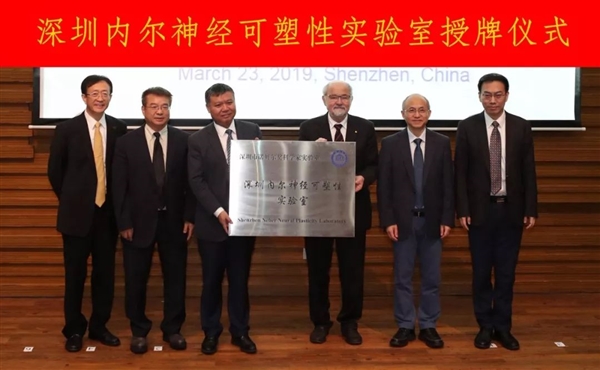
Shenzhen Nobel Prize Lab - Shenzhen Nair Neuroplastic Laboratory Awarding Ceremony
Fan Jianping, president of the Shenzhen Advanced Institute, said that the Brain Facilities and Shenzhen-Hong Kong Brain Hospital will unite the strengths of neuroscience in Guangdong, Hong Kong, Macao and Dawan Districts, in the brain cognitive basis, early diagnosis and intervention of brain diseases, human intelligence, brain science research. New technologies and other frontier fields have formed a synergy of innovation, developed into a carrier of innovative cooperation in the field of international brain science and brain technology, a base for innovation and development of new technologies for brain diseases, and an industry incubation platform for new drug research and development, with a view to making Guangdong, Hong Kong, Macao and Dawan District Brain science research provides an innovative platform that is large-scale, comprehensive, high-level, high-quality and in line with world-class teams.
Paper link: https://
N95 Dust Mask,N95 Protective Dust Mask,Protective Face Mask For Germs,Face Mask N95 Respirator
KUTA TECHNOLOGY INDUSTRY CO.,LIMITED , https://www.kutasureblue.com